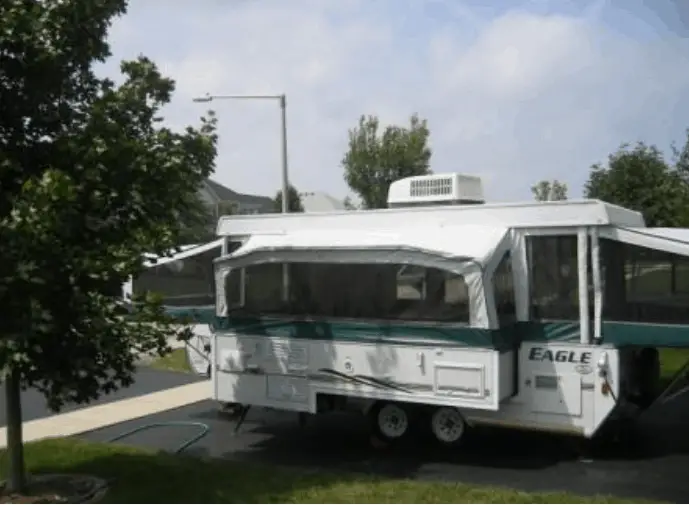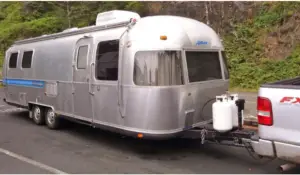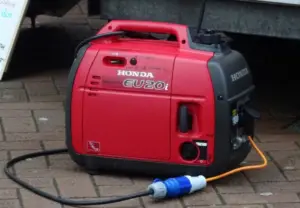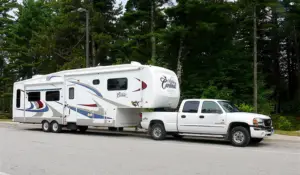Camping at a national park with your pop-up camper puts you close to beautiful natural sceneries. National parks have different regulations regarding the use of campers in their campsites.
They may also have restrictions on where guests can camp, the roads to take, and food storage options.
Before heading out to a particular campsite, you should check their website for information on camping.
In this guide, you’ll discover everything there’s to know about using pop-up campers in national parks.
Are Pop Up Campers Allowed in National Parks?
Did you visit a RV dealer recently who mentioned that pop up campers are not allowed in national parks? If yes, then you weren’t told the real truth!
The real fact is much different. Also, more than likely the salesman tried his hand at upselling you a costly hard sided trailer when you could have been better off with a low cost pop up camper.
Lets find out all the details.
National parks in the US do allow pop up campers and there are very few campgrounds in national parks that fully restrict pop up campers or other soft sided canvas based campers. Such restrictions are mostly due to bear activities in that region to keep people safe while camping.
Individual campgrounds in national parks always have their own restrictions and regulations that can include various things like how to keep food, length of the RV, stay duration and RV type as well. A lot depends on the campground location and wildlife activity.
Those with wildlife activities specially bear, normally have more restrictions. Even then, there aren’t many campgrounds that completely block pop up or canvas based campers.
To know such regulations you need to contact the campground staff or visit their website.
Yosemite national park allows pop up campers but there are restriction in place due to bear activities and you are required to keep food in bear proof storage boxes only. However, there is one campground in Yosemite that does not allow pop up camper.
Before heading out at the campground do check out campground’s rules and restriction. National parks will have some regulations but individual campgrounds will have detailed restriction and rules laid out that every user has to follow. Do check their website or brochure to get to know the full details.
Most campgrounds in national parks restrict pop up’s or trailers with canvas due to bear activities or other wildlife and want the people to be safe. Bears can attack a camper that is soft sided and tear off its canvas. So, if you are camping in such regions then make sure you do not keep food outside as its an open invitation for bears.
Bears can smell even tiny little pieces of food. It is for this reason that Yosemite or glacier nations park campgrounds do have restrictions.
Most national parks allow camper vehicles such as pickup trucks and VW buses with canvas pop ups. The pop-up camper should have a small unexposed trailer for you to gain entry into these parks.
It’s also common for a campground to ban pop-up campers for safety concerns. For instance, if the campground seeks to protect endangered animal species, they may impose this type of ban.
Also known as folding camping trailers, pop-up campers are affordable and relatively easy to use.
- Some national park administrators may impose a ban on them strictly for financial reasons. They may believe that pop-up campers are common with low-income people. Though this act is discriminatory, you may have no other option than to comply.
- Most national parks that we have visited did allow pop up campers and other canvas trailers. There are few that did not allow though and had some restrictions
- Fishing bridge campground in Yellowstone does not allow pop up campers and so does one campground in Yosemite. Sequoia national park, Joshua tree national park, zion national park or glacier national park, there are not many campgrounds in these national parks that would have restrictions for pop up campers at least not that we have seen.
So, next time a salesman tells you about ban on pop up campers ask for exact details on where it is banned.
Some campgrounds also have restriction for trailers due to narrow or twisting roads. Lengthy RVs are also not allowed in some campgrounds. Different campgrounds have different length restrictions. National parks also have length restrictions which can be found from their websites.
Sometimes you will also find separate campgrounds in national parks that are for tents, soft sided trailers, canvas/fabric campers or pop up campers.
Why Some Campgrounds and National Parks Don’t Allow Pop-up Campers?
Some campgrounds don’t allow recreational vehicles that are over five years old. The administrators may want to inspect your camper to check whether it meets their requirements. That’s because an older RV may pose a significant risk to the surrounding biodiversity.
A national park may also impose this type of ban to save on space. To them, larger motorhomes are convenient since they can accommodate more people. On the other hand, pop-up campers have tiny living spaces and may take a relatively large area on the ground overall.
National park administrators take their camping rules seriously. Everything in the campgrounds must abide by a pre-determined set of rules.
For instance, the sites need to have a particular number of RVs or landscaping. They may also require you to maintain specific colors and materials for your pop-up camper.
Since these rules help campgrounds keep the biodiversity sustainable and make profits, you have to abide by them. It’s a business to them at the end of the day. It’s also rare to find a pop-up camper in a high-end campground that charges over a hundred thousand dollars.
Pop up campers have canvas or fabric that a bear can tear off and access the interior which can be dangerous. Having said this, pop ups’s are better off as compared to plain tent camping. Pop up campers do have steel, aluminum support which can come to some protection. However, hard sided campers are better against bear attack.
Black bears normally enter campsites to get some easy food. Bears are attracted towards food smell, therefore if you are camping in such region make sure you do not keep open or outside on picnic tables.
How to Know if a Particular Campground or Park Allows Pop up or Not
While campgrounds have little differences between them, their camping processes are generally similar.
Each designated site corresponds to a specific letter or number (or a combination of numbers or letters). You’ll notice a piece of paper or a small card clipped to a post to outline the check-out-dates for the current guests in front-country campgrounds.
Frontcountry campgrounds are campgrounds that you drive to, while backcountry ones are accessible through hiking.
For backcountry campgrounds, you’ll have a tag on your backpack that you can use as a permit. Some national parks may require you to book in advance through their online booking systems. Their sites are usually available to campers on a “first-come, first-reserved” basis.
If you own a bigger RV then do check size restriction for the national park you are planning to visit.
Book a Site at the National Park’s Website
Before beginning your trip, find more information regarding fees, passes, and types of campers allowed from your park’s website. Most recreation sites and national parks ask for entrance passes.
You can also buy tokens physically at the park or on their online portal.
Booking your slot at a camping reservation website is more convenient than the traditional booking process. The website will ask you to choose the campground’s state, name, and nearest city. It will also ask you to describe the type of camper you would like to use during your trip.
National parks that allow pop-up campers will always avail this type of information on their website. You can also find and participate in an online forum comprising pop-up camper owners like you. This strategy will help you discover new campsites and share your experiences with others.
RV Length Length Limits of Various National Parks In the US
Your pop-up camper should meet various RV length restrictions imposed by the relevant national park.
The park’s administrators will deny you entry into the campground if your RV falls above or below the length restrictions.
Each of the country’s sixty-one national parks has varying length restrictions for RVs. The length restrictions make it easy for RVs to move in and out of campsites without causing traffic or congestion.
What’s the Average Length Restriction for RVs in National Parks?
The average length restriction for RVs looking to access a national park is 27 feet. You may find a park with a strict limit of 20 feet or one that allows Class A motorhomes of up to 40 feet.
Your pop-up camper will gain entry if it’s less than 12 feet in length. However, a handful of campgrounds have a permanent ban on pop up campers regardless of their size.
- About 90 percent of national park campgrounds house an RV that is 19 feet in length.
- You may use your RV on a campsite that allows RVs with a length of 25 feet. This exception only works if your vehicle meets the required length limit.
- Eighty percent of national parks will allow you to use your RV if it’s 29 to 32 feet long.
- For an RV with a length of up to 35 feet, more than 70 percent of the parks will accommodate you.
Close to half of the country’s natural parks have adequate space for RVs that are 37 feet long.
What if Few Slots are Available in the Campgrounds?
It’s common for national parks to have few slots available for the guests’ accommodation. For example, Yosemite has only twelve sites that accommodate RVs that are 40-feet long. Once the twelve slots have active reservations, you won’t get any space for camping.
National parks have separate length restrictions for pull-behind trailers. It’s important to revisit them before booking a site. Campgrounds that impose these restrictions usually have back-in-sites with a small or limited turning radius. If you have any trailers towed behind your RV, the limits will still apply to your vehicles.
It would help if you carefully considered the length of your RV and trailer as you plan your trip. If your motorhome sustains damage, it may be difficult for your insurer to compensate you since you didn’t abide by the park’s length restrictions.
You may visit campgrounds that aren’t under the federal park jurisdiction if your RV’s length exceeds 40 feet. Renting a smaller camper may help you access a national park if your RV is too large.
Which Popular National Parks Don’t Allow Pop Up Campers?
There’s no definitive list of popular national parks that allow or don’t allow pop-up campers. Therefore, it’s important to contact the particular park you want to visit for more information on their restrictions.
Furthermore, the location within the park may determine whether the campground allows or doesn’t allow pop-up campers.
Some parks impose temporary bans to curb habits or activities that endanger wildlife. Once the situation is under maximum control, the administrators tend to lift off the ban.
All the 61 national parks in the country have support staff ready and willing to respond to your queries.
US National Parks and Their Regulations for RVs in Terms of Length, Type, Others
National parks exist to preserve biodiversity by supporting the living creatures and ecosystem within them. They also protect the environment by reducing the climate change impacts and offering sustainable energy. For them to achieve these goals, they have to set certain rules and regulations.
Camping is one of the most widespread human activities in national parks.
Though the parks have slight differences between them, each of them has the following regulations in place:
1. Wild Animals
Park administrators will mandate you to close your vents, doors, and windows whenever you leave your RV or at night. You wouldn’t want to encounter a wild animal tearing apart your items.
It’s also advisable not to feed critters regardless of how you feel compassionate about them. This measure helps avoid food poisoning in the animals and prevents physical altercations with the animals.
Accidents involving humans and animals are common in national parks, especially if people fail to exercise caution. As much as you enjoy sightseeing and camping in wild areas, you should always keep a distance from predatory animals. The parks also have punitive measures to punish campers who breach their rules.
2. Trip Timing
National parks usually receive a lot of booking requests in the summer months, particularly July. The most in-demand park during this season is Yellowstone, thanks to its astonishingly beautiful sceneries.
Most park administrators are usually strict regarding the booking processes. Since the campgrounds tend to have few or limited slots during the summer, they only prioritize campers who book early.
You’re likely to miss your favorite campsite due to late booking. Furthermore, if you own a larger RV and there are fewer spots at the site, the administrators may not consider you.
The regulations on refunds and cancellations differ with the campground. Early fall or late spring is highly ideal for campers for tranquil or low-traffic months to visit national parks.
3. Pets
Though bringing your pet along with you when camping may be a good idea, there are specific rules you must follow. Most national parks grant dogs entry to the campgrounds free of charge. However, your dog should always have a 6-foot leash on it.
This measure helps prevent the dog from running deep into the wilderness, where it may encounter other predatory animals.
Park administrators will allow you to live with your dog in your camper, provided it has sufficient ventilation. You won’t walk with the pet on trails. However, the dog can accompany you to paved roads, picnic areas, and campgrounds. It’s also advisable to clean up after your dog to keep the campsite clean.
4. Length of Stay
Campsites are usually available to guests in an infinite amount of time. The park’s administrators have limitations on the specific length of time you can camp in one site. Since the exact timeframe differs with the park, most camps will require you to move on after staying at a site for 14 consecutive days.
Since national parks act as habitats for thousands of wild animals, expect to see animals roaming around the site. It will also be your duty to securely store your items to avoid loss or damage caused by the animals.
For parks with bears, you may keep your food in a bear box. Hanging your food from a tree may also work, provided the tree is higher than the animal’s height.
5. RV-Friendly Service Stations
It’s time-consuming and tiresome to drive from national park to national park along the highway. With the interests of campers in mind, several states created RV-friendly symbols on major highway service signs. These signs allow you to identify service stations and rest areas.
The RV-friendly service stations and rest areas feature roadway access of more than 12 feet. You won’t worry about overhead obstructions such as electrical wires when using them. Furthermore, you’ll also enjoy a swing radius of over 50 feet when entering or exiting the area.
You’ll find more than two parking spaces (12 by 65 feet in dimensions) in areas that allow short-term parking. These spots include tourist attractions, rest areas, and restaurants.
RV-friendly campgrounds have more than two parking spaces that measure 18 by 45 feet in dimensions. Search for RV-friendly symbols in Washington, Texas, Tennesse, Oregon, New Mexico, New Hampshire, Minnesota, Michigan, Louisiana, Iowa, Illinois, Idaho, Georgia, Florida, and California.
Conclusion
It’s highly fulfilling to camp in a national park with your pop-up camper. You’ll enjoy the simplicity of hooking the camper to the campground and entering and exiting the camper.
Furthermore, the pop-up camper can fit in your backyard under a tarp or in a garage when you want to store it. Always confirm from the national park’s website whether you can use a pop-up camper on their campgrounds before beginning the trip.




